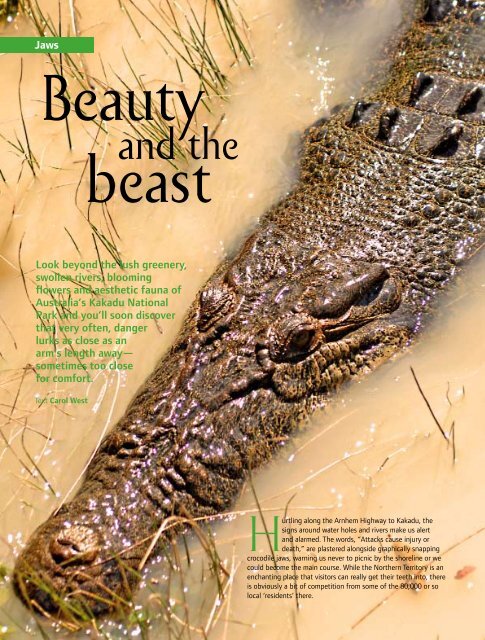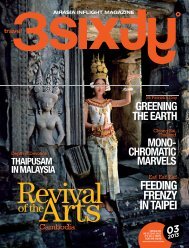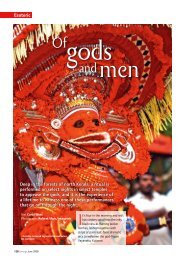Beauty beast
Fact file - imageink.com.au
Fact file - imageink.com.au
- No tags were found...
Create successful ePaper yourself
Turn your PDF publications into a flip-book with our unique Google optimized e-Paper software.
Jaws<strong>Beauty</strong>and the<strong>beast</strong>Look beyond the lush greenery,swollen rivers, bloomingflowers and aesthetic fauna ofAustralia’s Kakadu NationalPark and you’ll soon discoverthat very often, dangerlurks as close as anarm’s length away—sometimes too closefor comfort.Text Carol WestHurtling along the Arnhem Highway to Kakadu, thesigns around water holes and rivers make us alertand alarmed. The words, “Attacks cause injury ordeath,” are plastered alongside graphically snappingcrocodile jaws, warning us never to picnic by the shoreline or wecould become the main course. While the Northern Territory is anenchanting place that visitors can really get their teeth into, thereis obviously a bit of competition from some of the 80,000 or solocal ‘residents’ there.
Land of peril“Life jackets are under your seats. So if we capsize, form a circle,I’ll drop in the middle, and you can protect me as we try tobeat the crocs to shore,” jokes Mandy, our guide, as we embarkon the Yellow Water sunrise cruise. Dawn breaks cleanly overAustralia’s Top End, tingeing the sky hot pink with the promiseof big adventures. But it’s early for the estuarine crocodiles or‘salties’ that cruise Kakadu’s web of rivers and billabongs. Bysun-up, a few regulars are lurking near mud banks or tanglesof tree branches, but it’s difficult to spot the real deal from the‘logodiles’ (once facing extinction, with only 10 per cent reachingmaturity, it became a protected species in 1971 and numbershave been growing steadily since).What lurks beneath these moody, dense waters is wonderfullyjuxtaposed against the lushness of what’s above. Riversswollen from monsoonal rains have turned the floodplainsinto shimmering sheets of water teeming with life. Fringed bypandanus, bamboo, paperbark trees and monsoon rainforests,we spot night herons, known locally as the “I like myself a lot”birds, as they fly past admiring their reflections in the tranquilbillabong. Happy dancing Brolgas, whistling Kites and MagpieGeese all feast on juicy buffalo grass that carpets the floodplain.Delicate water lilies in blush pinks and whipped creams glow in awaterscape dripping with light.Prehistoric <strong>beast</strong>sFor tens of thousands of years, aboriginals lived an expansive lifein what is now Kakadu National Park, hunting with the seasonsand feasting on turtles, fish, crabs, fattened geese, yams andsnakes—all from nature’s supermarket. Kakadu retains an exotic,authentic, otherworldliness that only the vast Northern Territorycan dish-up, and those who know the land best maintain greatrespect for the black ‘salties.’ These submerged predators, whichonce swam with dinosaurs, can spring into frightening action,transforming into killing machines capable of moving eight timesfaster than any human.Still waters run deepCroc horror stories are legendary in the Northern Territory andour guide recalls one about a pair of European backpackers whodisappeared without a trace during an evening dip in a billabonga few years back. Over the years local newspaper headlines haveincluded “Crocs Stalk Man up Tree for a Week” and “Croc InvadesArmy Base”, recounting gory tales of people being taken bythese cold blooded killing machines who are primed and ready tomake a meal out of anyone foolish enough to enter their domain.Recently, a boatload of foreign visitors were ooh-ing and ah-ingover a cute wallaby by the riverbank when hello, lunch time!We all enjoy a good fright flick, and in the Australian movieRogue, a 7 metre long man-eating crocodile rises from beneaththe lotus lilies of a Kakadu billabong as he stalks a boatful ofpotential meals-to-go.uRight: Dummy lippery moss-covered rocks, the perilous.Facing page: ?Jetwings International August 2008 00
Keeping distance“No doubt about it, crocs have some very anti-social behaviourand are always fighting,” says Roman (our second guide along withMandy) as we cruise the East Alligator River aboard Guluyambi,known jokingly as ‘Titanic’. “I’m off the river by 6 p.m. as that’swhen the big boys come out and play rough,” he says, looking forthe telltale bubble trail of a submerged crocodile.A modern-day Crocodile Dundee wearing aviator sunglasses,khaki shorts and a bush shirt, he takes us on a journey thattraces aboriginal links to earth, wind, fire and water. The greatsandstone Arnhem Escarpment looms as a rugged backdrop to thisribbon of water that forms a flowing natural boundary betweenKakadu and Arnhem Land.The barramundi are biting, and men motor slowly past in tinnies(small metal fishing boats) that seem to be an entirely inadequatebuffer between man and <strong>beast</strong>. “Oh yeah, a croc’s been knownto leap into a boat; best to keep moving,” says Roman laconicallywhile demonstrating the impressive bounce-back lightness of abalsa fishing stick over a shop-bought line. Like the croc, this oldschool technology is so silent and precise that the fish never knowwhat hits them.uRight: Dummy lippery moss-covered rocks, the perilous.Below: ?Dummy the heart and soul, brainand poetry, and everything else ofthis wonderfully rich city.Flirting with danger“Croc at three o’clock!” he exclaims as the world’s largest reptilecruises into view. He’s had us in his sights long before we becameaware of him, and two small periscopic eyes are all we see as themurky waterline provides effective camouflage. His jaw resemblesa badly stitched, jagged wound profiling huge holding teeth thatenable him to take his victim. Prehistoric armour-plating acts likesolar panels, and using his powerful tail, his killing technique ofchoice is tearing the flesh. Seeing one up close, I shudder at thethought while marveling at 130 million years of evolution, andit sharpens my senses about the unknown and unseen here inKakadu.One of Australia’s leading natural attractions, Kakadu NationalPark is a cultural icon that’s vast in scale but intimate inexperiences. A 20,000 sq km World Heritage Site, to be conservedfor all time, Kakadu is one of only twenty sites declared so for bothits natural and cultural values. It also has mosquitoes and flies thathover around me like a squadron of B-52s on a bombing mission..00 Jetwings International August 2008
Fishy business“Bush medicine’s pretty powerful. We use the sap of the BeechHibiscus tree for mozzie bites,” says Roman, as we pass a fingerof water known as Cat Fish Creek, a popular aboriginal fishingspot. “We grind fresh water mangrove roots and dangle them ina string bag in the creek. Mangrove roots temporarily take theoxygen out of the water, hence stunning the fish, which thenfloat to the surface ready to be scooped up for supper,” saysRoman.Rounding a bend in the East Alligator River, we pull in to aglorious beach. “Two cyclones in two years demonstratednature’s awesome power to transform the landscape. Sevenmillion tonnes of sand were deposited, creating a desert wherea vast monsoon rainforest had once stood,” said Roman, turninga meteorological phenomenon into aboriginal mythology. Greatbeach, but pity about the swimming!Getting acquaintedTaking nature’s way along the Arnhem Highway back to Darwin,we stop at the Adelaide River where spectacular JumpingCrocodile Cruises deliver a ‘crocosaurus’ experience that has boththe croc and me leaping out of our skins.“That’s Michael Jackson. He’s black with a white face andchewed-up nose,” jokes the boatman as a 5-metre long maneaterglides towards us. There’s an estimated 150 crocodiles inthis waterway and for an hour, we get up close with Michael,Hannibal the Cannibal and some of their mates. With chunksof meat as performance enhancers, they powerfully propelthemselves upwards, twisting and spiralling their entire bodylength out of the water. Luring one high onto the riverbank,there are just two metres of metal boat between him and me.Despite constant warning signs, you don’t have to look toofar under the surface to see that there’s more to Kakaduthan crocodile spotting. There are rock art galleries to view,breathtaking sandstone landforms to explore, walks through easyand challenging terrains and blood red sunsets that saturate thesoul. We feel dwarfed by its haunting beauty, rugged landscapeand ancient culture and it provides a profound connection withimmense natural and spiritual worlds. It’s enough to send me tothe nearest bar for a croc-tail.00 Jetwings International August 2008
Fact fileGetting thereJet Airways has daily flights to Singapore from NewDelhi, Mumbai and Chennai from where our airlinepartner Qantas has connecting flights to Darwin,Australia. Kakadu is a two-hour (156 km) drive eastof Darwin via the Stuart and the Arnhem Highways.AccommodationAccommodation options at Kakadu include GagudjuCrocodile Holiday Inn (www.gagudju-dreaming.com),Gagudju Lodge Cooinda (www.gagudju-dreaming.com), Lakeview Park (www.lakeviewkakadu.com.au)and Aurora Kakadu Lodge (www.aurora-resorts.com.au)Travel tips- Access to some areas of the Park is limited atdifferent times due to rain so check the Park websitefor up-to-date information.- Two and four-wheel drive vehicles can be hiredfrom Avis, located in Darwin city and at airport. Forreservations log onto www.avis.com.auFor more information: Log on towww.deh.gov.au/parks/kakadu,www.travelnt.comJetwings International August 2008 00






